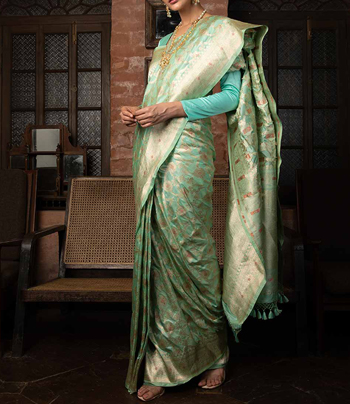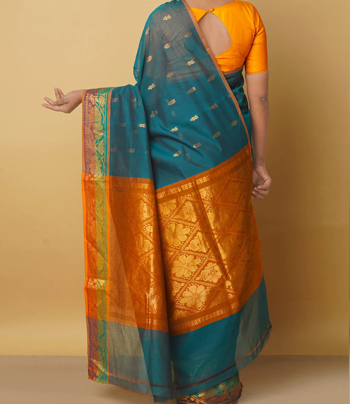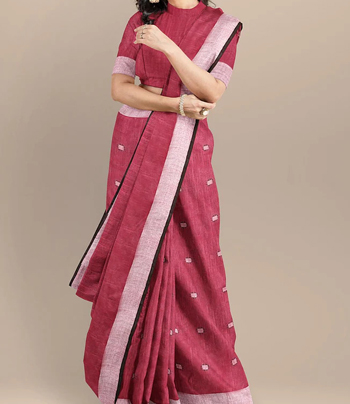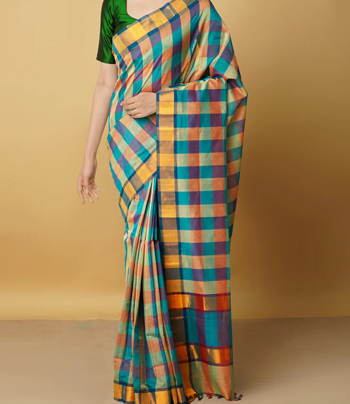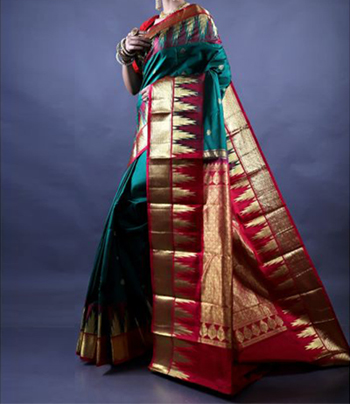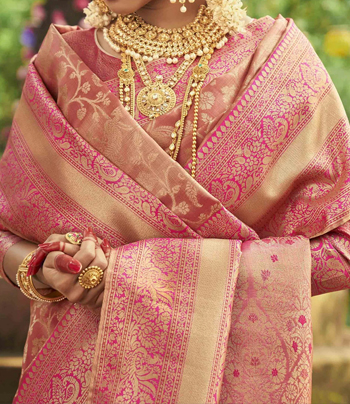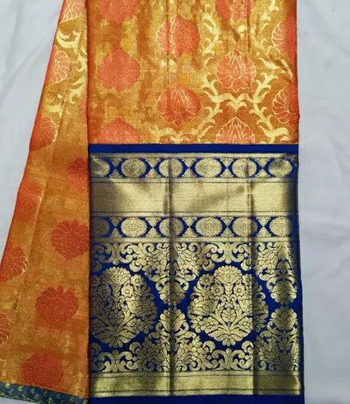Uppada Jamdani Sarees
Uppada Jamdani Sarees which are woven on cotton, silk, tussar or mercerized cotton or any combination of two or more of the same. Apart from sarees, chudidhar sets, scarfs, stoles, dress materials, textile and textile goods, bed and table covers, wall hangings, furnishing, furnishing mats, door and window curtains etc are also made by the Uppada artisans using the above said raw materials. The designs are intricately woven and are unique to the Uppada style of weaving. Further the special type of weaving using ada, jala and thillis contribute to the uniqueness of the goods. The specialty of the designs that is woven is that the design on the goods cannot be felt by the hand, separately from the surface of the cloth. That is the design blends into the cloth. Secondly the design is also clearly seen, distinct and distinguishable on the reverse side also. Further no loose threads can be seen on either side (front and back) of the design. This is a unique feature of Uppada Jamdani weaving. That apart the entire designs are hand woven without using any mechanical device such as a doby or jacquard which are special mechanisms fit into the loom to weave the designs in other forms of weaving.
Venkatagiri Sarees
Venkatagiri Sarees are essentially made of pure cotton, with elaborate zari work on them, with characteristic colors. The characteristic Venkatagiri saree is made of pure cotton, dyed using vat or Naphthol dyes, and zari woven into it by master weavers using silver and gold zari yarn obtained from Surat in Gujarat. The colors are bold, and do not run when the sarees are washed or soaked. This is largely attributed to the quality of the water in that region. Special care is taken to ensure that the water used for dyeing and treating the yarn is soft water. The workmanship primarily includes a bold ribbon of zari as border, and in the pallu of the sari, with traditional peacock, swan, mango, leaf and gold coin designs interspersed all over the saree. It is believed that no other variety of cotton saree incorporates the amount of elaborate zari work as in the Venkatagiri sarees. Besides, the Venkatagiri sarees are meant for very hot weather as they have fine texture and are suitable for various occasions. Hence the demand seems to exceed supply of these sarees.
Mangalagiri Sarees and Fabrics
Mangalagiri Sarees and fabrics are made of pure cotton fabric. The material is durable and produced in the Mangalagiri region near Guntur region of Andhra Pradesh. Though Mangalagiri weavers started their weaving with sarees, in more recent times, the cotton fabric itself has gained wide acclaim due to its colour variants, economical pricing, and environmentally friendly qualities. The Nizam border is the main characteristic of Mangalagiri sarees, which is now an essential part of chudidhar material and dupattas, is finely woven from pure zari specially procured from Surat in Gujarat. This border has intricate inverted checks with minute dots in between. The fabric is made in resplendent colours and also in vibrant short colours-combination of two or more colours which give a special sheen to the material. These features make Mangalagiri unique and outstanding. Durability and softness are the hallmark of Mangalagiri fabrics.
Dharmavaram Handloom Silk Sarees and Silk Pavadas
Dharmavaram Sarees are essentially made of pure mulberry silk, with elaborate zari work woven on them in resplendent colours. The characteristic Dharmavaram saree has broad solid colour borders with intricately woven brocaded gold borders. It is eco-friendly, highly durable and enhances the grandeur and aura of the lady wearing it in social functions. Though worn in all weather conditions, it is better suited for cool or cold climates. It is most appropriate for grand functions. Designs on the pallu and body of saree largely represent flora and fauna as also traditional legends of the country. Leaf, Flower, Fruit, animals and bird designs are largely incorporated in Dharmavaram sarees. More recently the weavers have improvised the weave of the zari to include various contemporary themes as seen in the pictures below. Peacock and Parrot designs are however the most popular and most traditionally used. The semi-arid tropical climate and the quality of water contribute to the fast nature of the yarn during production. Different combinations of workmanship on the saree are possible: a) One side Kuttu Saree b) Double side Kuttu Saree c) One side self Saree d) Double side self Saree e) One side semi contrast Saree f) Double side semi contrast Saree g) Evening and morning brocade saree h) Tape border saree (*Kuttu : A joining between the border and the body of the saree) All the above have varying degrees of zari work woven with dexterity to perfection, hitherto unprecedented. The ingenuity of the artisans has made it possible for exquisite weaving of themes like Ramayana and Mahabaratha on the sarees.
Source: Intellectual Property India

